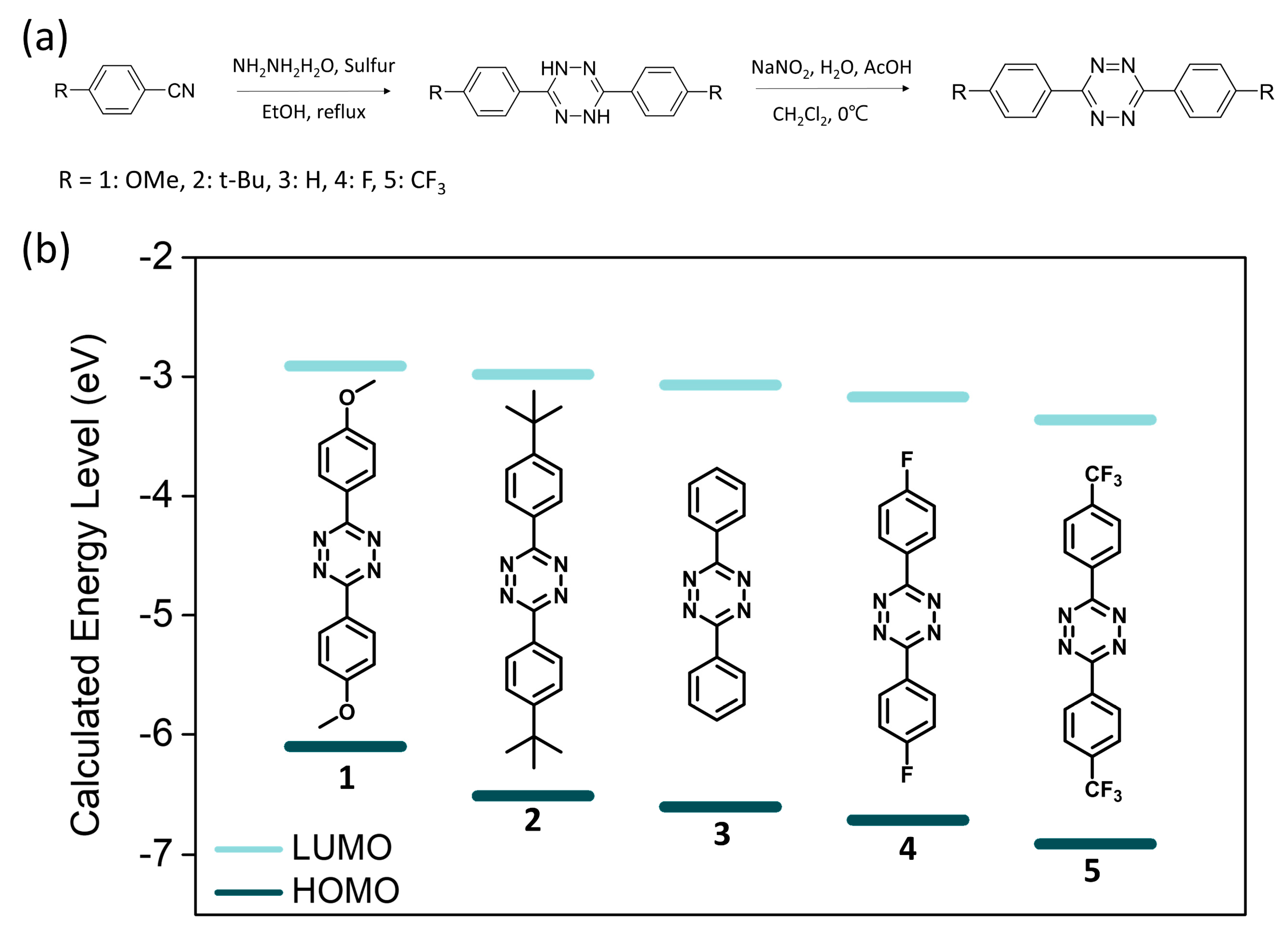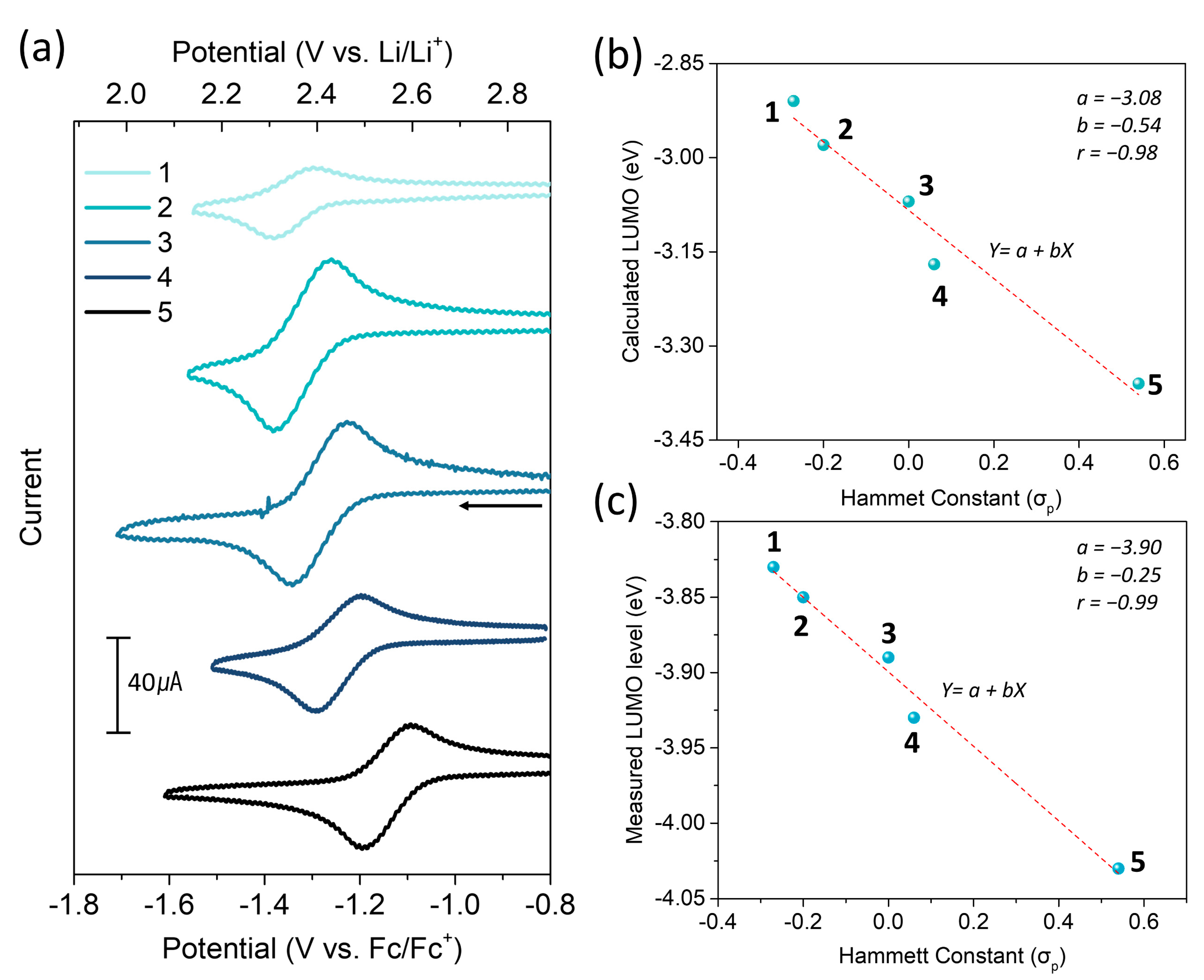Redox Potential Tuning of s-Tetrazine by Substitution of Electron-Withdrawing/Donating Groups for Organic Electrode Materials
Abstract
1. Introduction
2. Result and Discussion
2.1. Materials Design and Synthesis
2.2. Electrochemical Properties
2.3. Reduction Potential Prediction by DFT Calculation
2.4. CV and Galvanostatic Test in Coin Cells
3. Experimental Section
3.1. Synthesis of 1
3.2. Synthesis of 2
3.3. Synthesis of 4
3.4. Synthesis of 5
3.5. Electrochemical Measurement
3.6. Cathode Fabrication and Galvanostatic Test
3.7. Theoretical Calculation
4. Conclusions
Supplementary Materials
Author Contributions
Funding
Institutional Review Board Statement
Informed Consent Statement
Data Availability Statement
Conflicts of Interest
Sample Availability
References
- Häupler, B.; Wild, A.; Schubert, U.S. Carbonyls: Powerful Organic Materials for Secondary Batteries. Adv. Energy Mater. 2015, 5, 1402034. [Google Scholar] [CrossRef]
- Poizot, P.; Gaubicher, J.; Renault, S.; Dubois, L.; Liang, Y.; Yao, Y. Opportunities and Challenges for Organic Electrodes in Electrochemical Energy Storage. Chem. Rev. 2020, 120, 6490–6557. [Google Scholar] [CrossRef]
- Lee, S.; Kwon, G.; Ku, K.; Yoon, K.; Jung, S.-K.; Lim, H.-D.; Kang, K. Recent Progress in Organic Electrodes for Li and Na Rechargeable Batteries. Adv. Mater. 2018, 30, 1704682. [Google Scholar] [CrossRef]
- Lee, S.; Kwon, J.E.; Hong, J.; Park, S.Y.; Kang, K. The role of substituents in determining the redox potential of organic electrode materials in Li and Na rechargeable batteries: Electronic effects vs. substituent-Li/Na ionic interaction. J. Mater. Chem. A 2019, 7, 11438–11443. [Google Scholar] [CrossRef]
- Obrezkov, F.A.; Shestakov, A.F.; Traven, V.F.; Stevenson, K.J.; Troshin, P.A. An ultrafast charging polyphenylamine-based cathode material for high rate lithium, sodium and potassium batteries. J. Mater. Chem. A 2019, 7, 11430–11437. [Google Scholar] [CrossRef]
- Lu, Y.; Zhang, Q.; Li, L.; Niu, Z.; Chen, J. Design Strategies toward Enhancing the Performance of Organic Electrode Materials in Metal-Ion Batteries. Chem 2018, 4, 2786–2813. [Google Scholar] [CrossRef]
- Zhang, K.; Guo, C.; Zhao, Q.; Niu, Z.; Chen, J. High-Performance Organic Lithium Batteries with an Ether-Based Electrolyte and 9,10-Anthraquinone (AQ)/CMK-3 Cathode. Adv. Sci. 2015, 2, 1500018. [Google Scholar] [CrossRef]
- Lee, J.; Park, M.J. Tattooing Dye as a Green Electrode Material for Lithium Batteries. Adv. Energy Mater. 2017, 7, 1602279. [Google Scholar] [CrossRef]
- Wang, G.; Chandrasekhar, N.; Biswal, B.P.; Becker, D.; Paasch, S.; Brunner, E.; Addicoat, M.; Yu, M.; Berger, R.; Feng, X. A Crystalline, 2D Polyarylimide Cathode for Ultrastable and Ultrafast Li Storage. Adv. Mater. 2019, 31, 1901478. [Google Scholar] [CrossRef] [PubMed]
- Liang, Y.; Chen, Z.; Jing, Y.; Rong, Y.; Facchetti, A.; Yao, Y. Heavily n-Dopable π-Conjugated Redox Polymers with Ultrafast Energy Storage Capability. J. Am. Chem. Soc. 2015, 137, 4956–4959. [Google Scholar] [CrossRef] [PubMed]
- Oyaizu, K.; Nishide, H. Radical Polymers for Organic Electronic Devices: A Radical Departure from Conjugated Polymers? Adv. Mater. 2009, 21, 2339–2344. [Google Scholar] [CrossRef]
- Choi, W.; Ohtani, S.; Oyaizu, K.; Nishide, H.; Geckeler, K.E. Radical Polymer-Wrapped SWNTs at a Molecular Level: High-Rate Redox Mediation Through a Percolation Network for a Transparent Charge-Storage Material. Adv. Mater. 2011, 23, 4440–4443. [Google Scholar] [CrossRef]
- Deng, S.-R.; Kong, L.-B.; Hu, G.-Q.; Wu, T.; Li, D.; Zhou, Y.-H.; Li, Z.-Y. Benzene-based polyorganodisulfide cathode materials for secondary lithium batteries. Electrochim. Acta 2006, 51, 2589–2593. [Google Scholar] [CrossRef]
- Oyama, N.; Tatsuma, T.; Sato, T.; Sotomura, T. Dimercaptan–polyaniline composite electrodes for lithium batteries with high energy density. Nature 1995, 373, 598–600. [Google Scholar] [CrossRef]
- Armand, M.; Grugeon, S.; Vezin, H.; Laruelle, S.; Ribière, P.; Poizot, P.; Tarascon, J.M. Conjugated dicarboxylate anodes for Li-ion batteries. Nat. Mater. 2009, 8, 120–125. [Google Scholar] [CrossRef] [PubMed]
- Fédèle, L.; Sauvage, F.; Gottis, S.; Davoisne, C.; Salager, E.; Chotard, J.-N.; Becuwe, M. 2D-Layered Lithium Carboxylate Based on Biphenyl Core as Negative Electrode for Organic Lithium-Ion Batteries. Chem. Mater. 2017, 29, 546–554. [Google Scholar] [CrossRef]
- Min, D.J.; Miomandre, F.; Audebert, P.; Kwon, J.E.; Park, S.Y. s-Tetrazines as a New Electrode-Active Material for Secondary Batteries. ChemSusChem 2019, 12, 503–510. [Google Scholar] [CrossRef] [PubMed]
- Wiberg, K.B.; Lewis, T.P. Polarographic reduction of the azines. J. Am. Chem. Soc. 1970, 92, 7154–7160. [Google Scholar] [CrossRef]
- Clavier, G.; Audebert, P. s-Tetrazines as Building Blocks for New Functional Molecules and Molecular Materials. Chem. Rev. 2010, 110, 3299–3314. [Google Scholar] [CrossRef]
- Fritea, L.; Audebert, P.; Galmiche, L.; Gorgy, K.; Le Goff, A.; Villalonga, R.; Săndulescu, R.; Cosnier, S. First Occurrence of Tetrazines in Aqueous Solution: Electrochemistry and Fluorescence. ChemPhysChem 2015, 16, 3695–3699. [Google Scholar] [CrossRef]
- Samanta, S.; Ray, S.; Ghosh, A.B.; Biswas, P. 3,6-Di(pyridin-2-yl)-1,2,4,5-tetrazine (pytz) mediated metal-free mild oxidation of thiols to disulfides in aqueous medium. RSC Adv. 2016, 6, 39356–39363. [Google Scholar] [CrossRef]
- Vadehra, G.S.; Maloney, R.P.; Garcia-Garibay, M.A.; Dunn, B. Naphthalene Diimide Based Materials with Adjustable Redox Potentials: Evaluation for Organic Lithium-Ion Batteries. Chem. Mater. 2014, 26, 7151–7157. [Google Scholar] [CrossRef]
- Kim, H.; Kwon, J.E.; Lee, B.; Hong, J.; Lee, M.; Park, S.Y.; Kang, K. High Energy Organic Cathode for Sodium Rechargeable Batteries. Chem. Mater. 2015, 27, 7258–7264. [Google Scholar] [CrossRef]
- Park, Y.; Shin, D.-S.; Woo, S.H.; Choi, N.S.; Shin, K.H.; Oh, S.M.; Lee, K.T.; Hong, S.Y. Sodium Terephthalate as an Organic Anode Material for Sodium Ion Batteries. Adv. Mater. 2012, 24, 3562–3567. [Google Scholar] [CrossRef]
- Schon, T.B.; McAllister, B.T.; Li, P.-F.; Seferos, D.S. The rise of organic electrode materials for energy storage. Chem. Soc. Rev. 2016, 45, 6345–6404. [Google Scholar] [CrossRef] [PubMed]
- Abdel, N.O.; Kira, M.A.; Tolba, M.N. A direct synthesis of dihydrotetrazines. Tetrahedron Lett. 1968, 9, 3871–3872. [Google Scholar] [CrossRef]
- Audebert, P.; Sadki, S.; Miomandre, F.; Clavier, G.; Claude Vernières, M.; Saoud, M.; Hapiot, P. Synthesis of new substituted tetrazines: Electrochemical and spectroscopic properties. New J. Chem. 2004, 28, 387–392. [Google Scholar] [CrossRef]
- Cardona, C.M.; Li, W.; Kaifer, A.E.; Stockdale, D.; Bazan, G.C. Electrochemical considerations for determining absolute frontier orbital energy levels of conjugated polymers for solar cell applications. Adv. Mater. 2011, 23, 2367–2371. [Google Scholar] [CrossRef] [PubMed]
- Hansch, C.; Leo, A.; Taft, R.W. A survey of Hammett substituent constants and resonance and field parameters. Chem. Rev. 1991, 91, 165–195. [Google Scholar] [CrossRef]
- Gong, K.; Fang, Q.; Gu, S.; Li, S.F.Y.; Yan, Y. Nonaqueous redox-flow batteries: Organic solvents, supporting electrolytes, and redox pairs. Energy Environ. Sci. 2015, 8, 3515–3530. [Google Scholar] [CrossRef]
- Nicholson, R.S. Theory and Application of Cyclic Voltammetry for Measurement of Electrode Reaction Kinetics. Anal. Chem. 1965, 37, 1351–1355. [Google Scholar] [CrossRef]
- Fink, H.; Friedl, J.; Stimming, U. Composition of the Electrode Determines Which Half-Cell’s Rate Constant is Higher in a Vanadium Flow Battery. J. Phys. Chem. C 2016, 120, 15893–15901. [Google Scholar] [CrossRef]
- Takahashi, Y.; Yamashita, T.; Takamatsu, D.; Kumatani, A.; Fukuma, T. Nanoscale kinetic imaging of lithium ion secondary battery materials using scanning electrochemical cell microscopy. ChemComm 2020, 56, 9324–9327. [Google Scholar] [CrossRef]
- Tang, S.B.; Lai, M.O.; Lu, L. Li-ion diffusion in highly (003) oriented LiCoO2 thin film cathode prepared by pulsed laser deposition. J. Alloys Compd. 2008, 449, 300–303. [Google Scholar] [CrossRef]
- Yu, D.Y.W.; Fietzek, C.; Weydanz, W.; Donoue, K.; Inoue, T.; Kurokawa, H.; Fujitani, S. Study of LiFePO[sub 4] by Cyclic Voltammetry. J. Electrochem. Soc. 2007, 154, A253. [Google Scholar] [CrossRef]
- Tang, K.; Yu, X.; Sun, J.; Li, H.; Huang, X. Kinetic analysis on LiFePO4 thin films by CV, GITT, and EIS. Electrochim. Acta 2011, 56, 4869–4875. [Google Scholar] [CrossRef]
- Vitaku, E.; Gannett, C.N.; Carpenter, K.L.; Shen, L.; Abruña, H.D.; Dichtel, W.R. Phenazine-Based Covalent Organic Framework Cathode Materials with High Energy and Power Densities. J. Am. Chem. Soc. 2020, 142, 16–20. [Google Scholar] [CrossRef]
- Moral, M.; García, G.; Garzón, A.; Granadino-Roldán, J.M.; Fox, M.A.; Yufit, D.S.; Peñas, A.; Melguizo, M.; Fernández-Gómez, M. Electronic Structure and Charge Transport Properties of a Series of 3,6-(Diphenyl)-s-tetrazine Derivatives: Are They Suitable Candidates for Molecular Electronics? J. Phys. Chem. C 2014, 118, 26427–26439. [Google Scholar] [CrossRef]
- Lee, M.; Hong, J.; Lopez, J.; Sun, Y.; Feng, D.; Lim, K.; Chueh, W.C.; Toney, M.F.; Cui, Y.; Bao, Z. High-performance sodium–organic battery by realizing four-sodium storage in disodium rhodizonate. Nat. Energy 2017, 2, 861–868. [Google Scholar] [CrossRef]
- Meng, J.; Guo, H.; Niu, C.; Zhao, Y.; Xu, L.; Li, Q.; Mai, L. Advances in Structure and Property Optimizations of Battery Electrode Materials. Joule 2017, 1, 522–547. [Google Scholar] [CrossRef]
- Frisch, M.J.; Trucks, G.W.; Schlegel, H.B.; Scuseria, G.E.; Robb, M.A.; Cheeseman, J.R.; Scalmani, G.; Barone, V.; Mennuci, B.; Petersson, G.A.; et al. Gaussian 09, Revision, D.01; Gaussian Inc.: Wallingford, CT, USA, 2013. [Google Scholar]
- Venkateswaran, A.; Easterfield, J.R.; Davidson, D.W. A clathrate hydrate of 1,3-dioxolane. Can. J. Chem. 1967, 45, 884–886. [Google Scholar] [CrossRef]
- Côté, J.-F.; Brouillette, D.; Desnoyers, J.E.; Rouleau, J.-F.; St-Arnaud, J.-M.; Perron, G. Dielectric constants of acetonitrile, γ-butyrolactone, propylene carbonate, and 1,2-dimethoxyethane as a function of pressure and temperature. J. Solut. Chem. 1996, 25, 1163–1173. [Google Scholar] [CrossRef]
- Kim, K.C.; Liu, T.; Lee, S.W.; Jang, S.S. First-Principles Density Functional Theory Modeling of Li Binding: Thermodynamics and Redox Properties of Quinone Derivatives for Lithium-Ion Batteries. J. Am. Chem. Soc. 2016, 138, 2374–2382. [Google Scholar] [CrossRef] [PubMed]
- Liang, Y.; Zhang, P.; Chen, J. Function-oriented design of conjugated carbonyl compound electrodes for high energy lithium batteries. Chem. Sci. 2013, 4, 1330–1337. [Google Scholar] [CrossRef]
- Wang, Z.; Li, A.; Gou, L.; Ren, J.; Zhai, G. Computational electrochemistry study of derivatives of anthraquinone and phenanthraquinone analogues: The substitution effect. RSC Adv. 2016, 6, 89827–89835. [Google Scholar] [CrossRef]



| a HOMO (ev) | a LUMO (ev) | b Reduction Potential (E1/2) (V vs. Fc/Fc+) | c Oxidation Potential (Eonset) (V vs. Fc/Fc+) | d HOMO (ev) | d LUMO (ev) | |
|---|---|---|---|---|---|---|
| 1 | −6.02 | −2.71 | −1.34 | 1.29 | −6.39 | −3.76 |
| 2 | −6.31 | −2.80 | −1.32 | 1.42 | −6.52 | −3.78 |
| 3 | −6.46 | −2.96 | −1.28 | 1.48 | −6.58 | −3.82 |
| 4 | −6.67 | −3.17 | −1.25 | 1.51 | −6.61 | −3.85 |
| 5 | −7.01 | −3.50 | −1.14 | 1.60 | −6.70 | −3.96 |
| D (cm2 s−1) | k0 (cm s−1) | |
|---|---|---|
| 1 | 3.63 × 10−5 | 8.50 × 10−3 |
| 2 | 1.63 × 10−5 | 2.76 × 10−3 |
| 3 | 2.19 × 10−5 | 2.55 × 10−3 |
| 4 | 2.06 × 10−5 | 5.58 × 10−3 |
| 5 | 2.02 × 10−5 | 5.06 × 10−3 |
| DLi (cm2 s−1) for Cathodic Peak | DLi (cm2 s−1) for Anodic Peak | a Discharge Voltage (V vs. Li/Li+) | |
|---|---|---|---|
| 1 | 1.51 × 10−9 | 2.02 × 10−9 | 2.17 |
| 2 | 7.30 × 10−10 | 9.66 × 10−10 | 2.27 |
| 3 | 1.34 × 10−9 | 1.60 × 10−9 | 2.26 |
| 4 | 2.50 × 10−9 | 3.43 × 10−9 | 2.27 |
| 5 | 1.45 × 10−9 | 3.08 × 10−9 | 2.28 |
Publisher’s Note: MDPI stays neutral with regard to jurisdictional claims in published maps and institutional affiliations. |
© 2021 by the authors. Licensee MDPI, Basel, Switzerland. This article is an open access article distributed under the terms and conditions of the Creative Commons Attribution (CC BY) license (http://creativecommons.org/licenses/by/4.0/).
Share and Cite
Min, D.J.; Lee, K.; Park, H.; Kwon, J.E.; Park, S.Y. Redox Potential Tuning of s-Tetrazine by Substitution of Electron-Withdrawing/Donating Groups for Organic Electrode Materials. Molecules 2021, 26, 894. https://doi.org/10.3390/molecules26040894
Min DJ, Lee K, Park H, Kwon JE, Park SY. Redox Potential Tuning of s-Tetrazine by Substitution of Electron-Withdrawing/Donating Groups for Organic Electrode Materials. Molecules. 2021; 26(4):894. https://doi.org/10.3390/molecules26040894
Chicago/Turabian StyleMin, Dong Joo, Kyunam Lee, Hyunji Park, Ji Eon Kwon, and Soo Young Park. 2021. "Redox Potential Tuning of s-Tetrazine by Substitution of Electron-Withdrawing/Donating Groups for Organic Electrode Materials" Molecules 26, no. 4: 894. https://doi.org/10.3390/molecules26040894
APA StyleMin, D. J., Lee, K., Park, H., Kwon, J. E., & Park, S. Y. (2021). Redox Potential Tuning of s-Tetrazine by Substitution of Electron-Withdrawing/Donating Groups for Organic Electrode Materials. Molecules, 26(4), 894. https://doi.org/10.3390/molecules26040894






